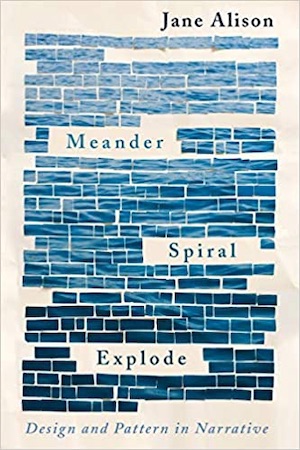By David Madden
Although as reader, novelist, and as teacher of creative writing for 60 years, I find little of use in Jane Alison’s Meander, Spiral, Explode: Design and Pattern in Narrative, I recommend it highly, because I imagine others may make use of it.
Setting Aristotle respectfully aside, Alison describes new modes of experimental fiction. Her book is “a museum of specimens,” exhibiting long summaries of and commentaries on about 30 novels and stories by writers “exploiting the visual and finding patterns other than the arc inside their stories.”
The author of four novels and a professor of creative writing, Alison expresses her views and insights lucidly. “SPIRAL: think of a fiddlehead fern, whirlpool, hurricane, horns twisting from a ram’s head, or a chambered nautilus. MEANDER: picture a river curving and kinking, a snake in motion, a snail’s silver trail, or the path left by a goat grazing the tenderest greens. RADIAL OR EXPLOSION: a splash of dripping water, petals growing from a daisy’s heart, light radiating from the sun, the ring left around a tick bite.”
Along with five other novels, Marguerite Duras’ The Lover, about the rise and fall of a sexual affair,serves to illustrate Alison’s concept of “meander” as a form. “Reading The Lover might be like following the Mekong River and its oxbow.” It “works with two patterns at once, moiré: a wave and a meander.”
Among other writers, Alison analyses works by Joyce Carol Oates, Nabokov, Philip Roth, Robbe-Grillet, Susan Minot, and Raymond Carver.
The very terms she has marshaled vividly describe ways the works she has chosen might be read and possibilities that fiction writers might explore: meander, spiral, explode, point, line, texture, flow, color, waves and wavelets, radials, networks, cells, fractals, narrative hydraulics, tsunami, vitality held, and relentless repetition, as in pieces by Gertrude Stein and Jamaica Kincaid.
Listening to Franz Shubert’s “Fantasy in F Minor” for four hands last night, I longed to be able to write a novel patterned, with varied pace, after musical form. So I do appreciate Jane Alison’s desire to orchestrate a new approach to fiction. Her writing is lyrical, and her book is symphonic.
David Madden is the author of 11 novels and 4 collections of stories, the latest of which is Marble Goddesses and Mortal Flesh. Revising Fiction delineates his advocacy for an emphasis upon the craft of fiction. His most recent work is The Voice of James M. Cain: An Innovative Biography.




